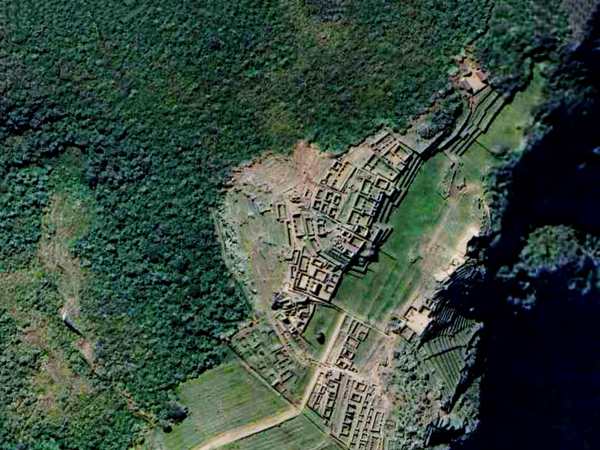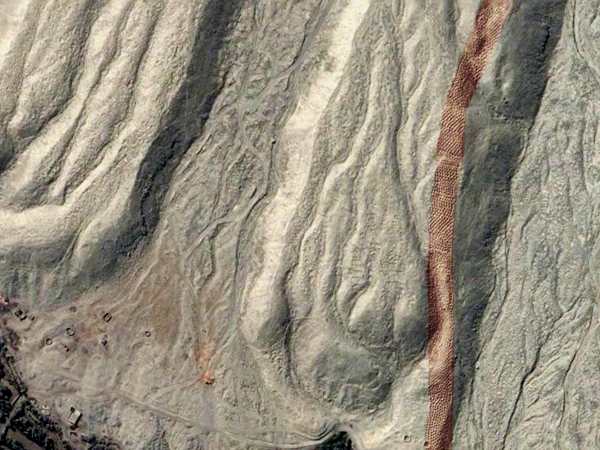In the rugged terrain of Cajamarquilla, near Pisco Valley in Peru, a baffling array of man-sized holes stretches over a mile of uneven mountain landscape. These strange formations, visible only from the air, have puzzled locals and experts alike. Their origins remain a mystery, with theories ranging from ancient storage solutions to potential burial sites. Despite extensive research and speculation, no conclusive answers have emerged.
The Mysterious Holes of Cajamarquilla
The Cajamarquilla plain is dotted with thousands of holes carved into the barren rock. These depressions vary in depth from about 6 to 7 feet, with some appearing as shallow indentations. The holes are meticulously arranged, with some forming rows that arch gracefully, while others appear staggered in seemingly random patterns. The sheer scale and precision of these formations raise intriguing questions about their purpose and creators.
Archaeologists initially proposed that the holes might have been used to store grain. However, this theory faces two major challenges. Firstly, the effort required to carve out thousands of these holes seems disproportionate compared to simpler storage solutions. Secondly, if grain storage was the goal, one would expect to find larger chambers or structures rather than numerous small holes.
Another theory suggests that the holes could be one-person tombs or vertical graves. Yet, this idea is undermined by the absence of any associated artifacts, bones, or inscriptions. No covers or sealing mechanisms are present, and local folklore does not reference these formations as burial sites. The lack of historical or mythological context further complicates their classification.
Theories and Speculations
Theories about the purpose of these holes have ranged from practical to fantastical. Some experts have compared them to formations left by drilling rigs or laser surveys, noting their repetitive and uniform appearance. This comparison hints at the possibility of a large-scale geological survey or exploration, but there is no evidence to support this idea.
Even renowned researcher Erich von Däniken, known for his controversial theories about ancient extraterrestrial influences, found these holes intriguing. His 1933 National Geographic article mentioned similar formations, which he inspected years later. The uniformity and precision of the holes remind some of modern techniques used for geological exploration, but no conclusive link has been established.
Archaeologists have also proposed that the holes could represent defensive positions or ancient fortifications. However, the idea of using such formations as defensive structures on a steep, rocky slope seems impractical. The extreme angle and rugged terrain would make it challenging to defend or utilize these locations effectively.
Unsettling Discoveries and Satellite Imagery
An unusual feature of the northern end of the hole formation is its abrupt transition into a darker, seemingly explosion-like area. This section appears different from the rest, with a distinct, unnatural appearance. Such anomalies add to the speculation about the holes’ origins, suggesting possible external influences or catastrophic events.
Further investigation using satellite imagery has revealed additional intriguing features. A few miles east of the main formation, images show structures that resemble remnants of an ancient settlement. These formations do not appear natural and are unique in the surrounding area. The coordinates for these structures are approximately 13°42’36.80″ S, 75°51’4.07″ W. Comparing these structures to the well-known site of Machu Picchu highlights their distinctiveness and adds another layer to the mystery.

The Ongoing Search for Answers
The enigmatic holes of Cajamarquilla continue to intrigue researchers, historians, and archaeologists. Despite various theories and technological advancements, no definitive explanation has been found. The lack of artifacts, historical records, or clear functional purposes leaves the mystery unresolved.
Researchers are eager to explore further and test new hypotheses using advanced techniques such as ground-penetrating radar and more detailed satellite imaging. The goal is to uncover any hidden features or structures that might provide clues about the purpose of these mysterious holes.
In the absence of concrete evidence, the Cajamarquilla holes remain a fascinating puzzle. Whether they are remnants of an ancient civilization’s practical solutions, defensive positions, or something entirely different, they continue to spark curiosity and debate. As technology advances and new discoveries are made, the hope remains that one day the true purpose of these holes will be revealed.

